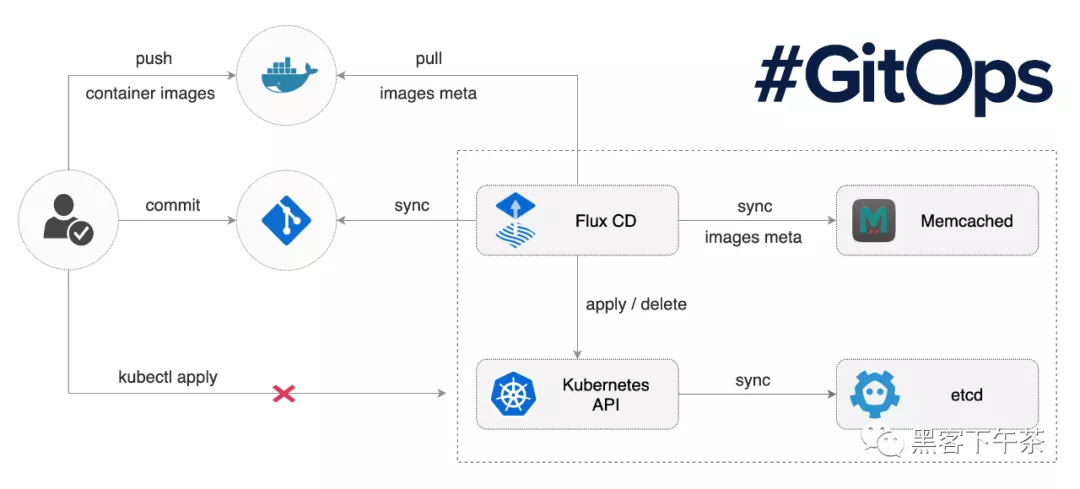对于此示例,我们假设有两个集群的场景:暂存(staging)和生产(production)。最终目标是利用 Flux 和 Kustomize 来管理两个集群,同时最大限度地减少重复声明。
我们将配置 Flux 以使用 HelmRepository 和 HelmRelease 自定义资源安装、测试和升级演示应用程序。 Flux 将监控 Helm 存储库,并根据 semver 范围自动将 Helm 版本升级到最新的 chart 版本。
准备工作
flux2-kustomize-helm-example
- https://github.com/fluxcd/flux2-kustomize-helm-example
您将需要 Kubernetes 集群版本 1.16 或更新版本以及 kubectl 版本 1.18 或更新。对于快速的本地测试,您可以使用 Kubernetes kind。不过,任何其他 Kubernetes 设置也可以正常工作。
为了遵循本指南,您需要一个 GitHub 帐户和一个可以创建存储库的 personal access token(检查 repo 下的所有权限)。
使用 Homebrew 在 MacOS 和 Linux 上安装 Flux CLI:
- brew install fluxcd/tap/flux
或者通过使用 Bash 脚本下载预编译的二进制文件来安装 CLI:
- curl -s https://fluxcd.io/install.sh | sudo bash
项目结构
Git 存储库包含以下顶级目录:
- apps 目录包含每个集群具有自定义配置的 Helm 版本
- infrastructure 目录包含常见的基础设施工具,例如 NGINX ingress controller 和 Helm 存储库定义
- clusters 目录包含每个集群的 Flux 配置
- ├── apps
- │ ├── base
- │ ├── production
- │ └── staging
- ├── infrastructure
- │ ├── nginx
- │ ├── redis
- │ └── sources
- └── clusters
- ├── production
- └── staging
apps 配置结构为:
- apps/base/ 目录包含命名空间和 Helm 发布定义(release definitions)
- apps/production/ 目录包含生产 Helm 发布值(release values)
- apps/staging/ 目录包含 staging values
- ./apps/
- ├── base
- │ └── podinfo
- │ ├── kustomization.yaml
- │ ├── namespace.yaml
- │ └── release.yaml
- ├── production
- │ ├── kustomization.yaml
- │ └── podinfo-patch.yaml
- └── staging
- ├── kustomization.yaml
- └── podinfo-patch.yaml
在 apps/base/podinfo/ 目录中,我们有一个 HelmRelease,两个集群都有共同的值:
- apiVersion: helm.toolkit.fluxcd.io/v2beta1
- kind: HelmRelease
- metadata:
- name: podinfo
- namespace: podinfo
- spec:
- releaseName: podinfo
- chart:
- spec:
- chart: podinfo
- sourceRef:
- kind: HelmRepository
- name: podinfo
- namespace: flux-system
- interval: 5m
- values:
- cache: redis-master.redis:6379
- ingress:
- enabled: true
- annotations:
- kubernetes.io/ingress.class: nginx
- path: "/*"
在 apps/staging/ 目录中,我们有一个带有 staging 特定值的 Kustomize 补丁(patch):
- apiVersion: helm.toolkit.fluxcd.io/v2beta1
- kind: HelmRelease
- metadata:
- name: podinfo
- spec:
- chart:
- spec:
- version: ">=1.0.0-alpha"
- test:
- enable: true
- values:
- ingress:
- hosts:
- - podinfo.staging
请注意,使用 version: ">=1.0.0-alpha" 我们配置 Flux 以自动将 HelmRelease 升级到最新的 chart 版本,包括 alpha、beta 和预发布(pre-releases)。
在 apps/production/ 目录中,我们有一个带有生产特定值的 Kustomize 补丁:
- apiVersion: helm.toolkit.fluxcd.io/v2beta1
- kind: HelmRelease
- metadata:
- name: podinfo
- namespace: podinfo
- spec:
- chart:
- spec:
- version: ">=1.0.0"
- values:
- ingress:
- hosts:
- - podinfo.production
请注意,使用 version: ">=1.0.0" 我们配置 Flux 以自动将 HelmRelease 升级到 最新的稳定 chart 版本(alpha、beta 和 pre-releases 将被忽略)。
基础设施:
- ./infrastructure/
- ├── nginx
- │ ├── kustomization.yaml
- │ ├── namespace.yaml
- │ └── release.yaml
- ├── redis
- │ ├── kustomization.yaml
- │ ├── namespace.yaml
- │ └── release.yaml
- └── sources
- ├── bitnami.yaml
- ├── kustomization.yaml
- └── podinfo.yaml
在 infrastructure/sources/ 目录中,我们有 Helm 存储库定义:
- apiVersion: source.toolkit.fluxcd.io/v1beta1
- kind: HelmRepository
- metadata:
- name: podinfo
- spec:
- interval: 5m
- url: https://stefanprodan.github.io/podinfo
- ---
- apiVersion: source.toolkit.fluxcd.io/v1beta1
- kind: HelmRepository
- metadata:
- name: bitnami
- spec:
- interval: 30m
- url: https://charts.bitnami.com/bitnami
请注意,使用 interval: 5m 我们将 Flux 配置为每五分钟拉一次 Helm 存储库索引。如果索引包含与 HelmRelease semver 范围匹配的新 chart 版本,Flux 将升级该版本。
Bootstrap staging 和 production
集群目录包含 Flux 配置:
- ./clusters/
- ├── production
- │ ├── apps.yaml
- │ └── infrastructure.yaml
- └── staging
- ├── apps.yaml
- └── infrastructure.yaml
在 clusters/staging/ 目录中,我们有 Kustomization 定义:
- apiVersion: kustomize.toolkit.fluxcd.io/v1beta1
- kind: Kustomization
- metadata:
- name: apps
- namespace: flux-system
- spec:
- interval: 10m0s
- dependsOn:
- - name: infrastructure
- sourceRef:
- kind: GitRepository
- name: flux-sytem
- path: ./apps/staging
- prune: true
- validation: client
- ---
- apiVersion: kustomize.toolkit.fluxcd.io/v1beta1
- kind: Kustomization
- metadata:
- name: infrastructure
- namespace: flux-system
- spec:
- interval: 10m0s
- sourceRef:
- kind: GitRepository
- name: flux-system
- path: ./infrastructure
请注意,使用 path: ./apps/staging 我们配置 Flux 以同步暂存 Kustomize 覆盖,并使用 dependsOn 我们告诉 Flux 在部署应用程序之前创建基础设施项。
在您的个人 GitHub 帐户上 Fork 此存储库并导出您的 GitHub access token、用户名和存储库名称:
- export GITHUB_TOKEN=<your-token>
- export GITHUB_USER=<your-username>
- export GITHUB_REPO=<repository-name>
验证您的临时集群是否满足先决条件:
- flux check --pre
将 kubectl context 设置为您的 staging 集群和 bootstrap Flux:
- flux bootstrap github \
- --context=staging \
- --owner=${GITHUB_USER} \
- --repository=${GITHUB_REPO} \
- --branch=main \
- --personal \
- --path=clusters/staging
bootstrap 命令在 clusters/staging/flux-system 目录中提交 Flux 组件的清单,并在 GitHub 上创建一个具有只读访问权限的部署密钥,因此它可以在集群内拉取更改(pull changes)。
注意在 staging 上安装的 Helm releases:
- $ watch flux get helmreleases --all-namespaces
- NAMESPACE NAME REVISION SUSPENDED READY MESSAGE
- nginx nginx 5.6.14 False True release reconciliation succeeded
- podinfo podinfo 5.0.3 False True release reconciliation succeeded
- redis redis 11.3.4 False True release reconciliation succeeded
验证 demo app 是否可以通过 ingress 访问:
- $ kubectl -n nginx port-forward svc/nginx-ingress-controller 8080:80 &
- $ curl -H "Host: podinfo.staging" http://localhost:8080
- {
- "hostname": "podinfo-59489db7b5-lmwpn",
- "version": "5.0.3"
- }
通过设置生产集群的上下文和路径来引导生产上的 Flux:
- flux bootstrap github \
- --context=production \
- --owner=${GITHUB_USER} \
- --repository=${GITHUB_REPO} \
- --branch=main \
- --personal \
- --path=clusters/production
监控 production reconciliation:
- $ watch flux get kustomizations
- NAME REVISION READY
- apps main/797cd90cc8e81feb30cfe471a5186b86daf2758d True
- flux-system main/797cd90cc8e81feb30cfe471a5186b86daf2758d True
- infrastructure main/797cd90cc8e81feb30cfe471a5186b86daf2758d True
加密 Kubernetes secrets
为了将 secrets 安全地存储在 Git 存储库中, 您可以使用 Mozilla 的 SOPS CLI 通过 OpenPGP 或 KMS 加密 Kubernetes secrets。
安装 gnupg 和 sops:
- brew install gnupg sops
为 Flux 生成一个不指定密码短语(passphrase)的 GPG key,并获取GPG key ID:
- $ gpg --full-generate-key
- Email address: fluxcdbot@users.noreply.github.com
- $ gpg --list-secret-keys fluxcdbot@users.noreply.github.com
- sec rsa3072 2020-09-06 [SC]
- 1F3D1CED2F865F5E59CA564553241F147E7C5FA4
使用 private key 在集群上创建 Kubernetes secret:
- gpg --export-secret-keys \
- --armor 1F3D1CED2F865F5E59CA564553241F147E7C5FA4 |
- kubectl create secret generic sops-gpg \
- --namespace=flux-system \
- --from-file=sops.asc=/dev/stdin
生成 Kubernetes secret manifest 并使用 sops 加密 secret 的数据字段:
- kubectl -n redis create secret generic redis-auth \
- --from-literal=password=change-me \
- --dry-run=client \
- -o yaml > infrastructure/redis/redis-auth.yaml
- sops --encrypt \
- --pgp=1F3D1CED2F865F5E59CA564553241F147E7C5FA4 \
- --encrypted-regex '^(data|stringData)$' \
- --in-place infrastructure/redis/redis-auth.yaml
添加 secret 到 infrastructure/redis/kustomization.yaml:
- apiVersion: kustomize.config.k8s.io/v1beta1
- kind: Kustomization
- namespace: redis
- resources:
- - namespace.yaml
- - release.yaml
- - redis-auth.yaml
通过编辑 infrastructure.yaml 文件在集群上启用解密:
- apiVersion: kustomize.toolkit.fluxcd.io/v1beta1
- kind: Kustomization
- metadata:
- name: infrastructure
- namespace: flux-system
- spec:
- # content omitted for brevity
- decryption:
- provider: sops
- secretRef:
- name: sops-gpg
导出公钥(public key),以便任何有权访问存储库的人都可以加密 secrets 但不能解密它们:
- gpg --export -a fluxcdbot@users.noreply.github.com > public.key
将更改推送到主分支:
- git add -A && git commit -m "add encrypted secret" && git push
验证是否已在两个集群的 redis 命名空间中创建了 secret:
- kubectl --context staging -n redis get secrets
- kubectl --context production -n redis get secrets
您可以使用 Kubernetes secrets 为您的 Helm releases 提供值:
- apiVersion: helm.toolkit.fluxcd.io/v2beta1
- kind: HelmRelease
- metadata:
- name: redis
- spec:
- # content omitted for brevity
- values:
- usePassword: true
- valuesFrom:
- - kind: Secret
- name: redis-auth
- valuesKey: password
- targetPath: password
在 docs 中了解有关 Helm releases values 覆盖的更多信息。
添加集群
如果要将集群添加到你的 fleet 中,请先在本地克隆存储库:
- git clone https://github.com/${GITHUB_USER}/${GITHUB_REPO}.git
- cd ${GITHUB_REPO}
使用您的集群名称在 clusters 中创建一个目录:
- mkdir -p clusters/dev
从 staging 复制同步清单:
- cp clusters/staging/infrastructure.yaml clusters/dev
- cp clusters/staging/apps.yaml clusters/dev
您可以在 apps 内创建一个 dev overlay,确保将 clusters/dev/apps.yaml 内的 spec.path 更改为 path: ./apps/dev。
将更改推送到主分支:
- git add -A && git commit -m "add dev cluster" && git push
将 kubectl 上下文和路径设置为您的 dev cluster 并引导 Flux:
- flux bootstrap github \
- --context=dev \
- --owner=${GITHUB_USER} \
- --repository=${GITHUB_REPO} \
- --branch=main \
- --personal \
- --path=clusters/dev
相同的环境
如果你想启动一个相同的环境,你可以引导一个集群,例如 production-clone 并重用 production 定义。
引导 production-clone 集群:
- flux bootstrap github \
- --context=production-clone \
- --owner=${GITHUB_USER} \
- --repository=${GITHUB_REPO} \
- --branch=main \
- --personal \
- --path=clusters/production-clone
在本地拉取更改:
- git pull origin main
在 clusters/production-clone 目录中创建一个 kustomization.yaml:
- apiVersion: kustomize.config.k8s.io/v1beta1
- kind: Kustomization
- resources:
- - flux-system
- - ../production/infrastructure.yaml
- - ../production/apps.yaml
请注意,除了 flux-system kustomize overlay,我们还包括来自 production 目录的 infrastructure 和 apps 清单。
将更改推送到主分支:
- git add -A && git commit -m "add production clone" && git push
告诉 Flux 在 production-clone 集群上部署生产工作负载(production workloads):
- flux reconcile kustomization flux-system \
- --context=production-clone \
- --with-source







































